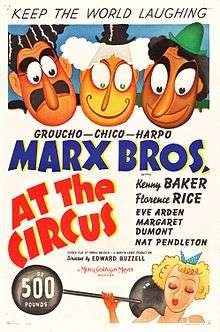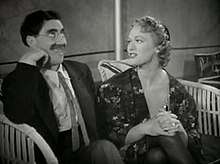At the Circus
At the Circus (sometimes called The Marx Brothers at the Circus) is a 1939 comedy film starring the Marx Brothers released by Metro-Goldwyn-Mayer in which they help save a circus from bankruptcy. The film contains Groucho Marx's rendition of "Lydia the Tattooed Lady". The supporting cast includes Florence Rice, Kenny Baker, Margaret Dumont, and Eve Arden. The songs, including "Lydia the Tattooed Lady", "Two Blind Loves", and "Step Up and Take a Bow", were written by the team of Harold Arlen and Yip Harburg.
| At the Circus | |
|---|---|
 | |
| Directed by | Edward Buzzell |
| Produced by | Mervyn LeRoy |
| Written by | Irving Brecher Buster Keaton (uncredited) Laurence Stallings (uncredited) |
| Starring | Groucho Marx Chico Marx Harpo Marx Florence Rice Kenny Baker Margaret Dumont Eve Arden |
| Music by | Franz Waxman |
| Cinematography | Leonard M. Smith |
| Edited by | William H. Terhune |
| Distributed by | Metro-Goldwyn-Mayer |
Release date |
|
Running time | 87 minutes |
| Country | United States |
| Language | English |
Plot
Goliath, the circus strongman (Nat Pendleton) and the midget, Little Professor Atom (Jerry Maren), are accomplices of bad guy John Carter (James Burke) who is trying to take over the Wilson Wonder Circus. Julie Randall (Florence Rice) performs a horse act in the circus. In the animal car on the circus train, Goliath and Atom knock out Julie's boyfriend, Jeff Wilson (Kenny Baker), and steal $10,000, which Jeff owes Carter.
Jeff's friend and circus employee, Antonio 'Tony' Pirelli, (Chico), summons attorney J. Cheever Loophole (Groucho) to handle the situation. Loophole caves in when he sees the muscular Goliath, and gets nowhere with Little Professor Atom. In order to help Wilson, he first tries to get the hidden money from Carter's moll, Peerless Pauline (Eve Arden), but fails. Tony and Punchy (Harpo) search Goliath's stateroom on the circus train for the money, but are unsuccessful.
Loophole calls upon Jeff's wealthy aunt, Mrs. Dukesbury (Margaret Dumont), and tricks her into paying $10,000 for the Wilson Wonder Circus to entertain the Newport 400, instead of a performance by French conductor Jardinet (Fritz Feld), and his symphony orchestra. The audience is delighted with the circus; when Jardinet arrives, Loophole, who also delayed the Frenchman by implicating him in a dope ring, disposes of the conductor and his orchestra by having Tony and Punchy cut the moorings on a floating bandstand as they play Wagner's prelude to act III of Lohengrin at the water's edge.
Meanwhile, Carter and his henchmen try to burn down the circus, but are thwarted by Loophole, Tony, and Punchy, along with the only witness to the robbery: Gibraltar the gorilla (Charles Gemora), who also retrieves Wilson's money after a big trapeze finale, featuring Mrs. Dukesbury being shot out of a cannon.
Cast
- Groucho Marx as Attorney J. Cheever Loophole
- Chico Marx as Antonio "Tony" Pirelli
- Harpo Marx as "Punchy"
- Kenny Baker as Jeff Wilson
- Florence Rice as Julie Randall
- Eve Arden as Peerless Pauline
- Margaret Dumont as Mrs. Susanna Dukesbury
- Nat Pendleton as Goliath the Strongman
- Fritz Feld as Jardinet
- James Burke as John Carter
- Jerry Maren as Little Professor Atom (credited as Jerry Marenghi)
- Barnett Parker as Whitcomb
- Edmund Mortimer as Judge Chanock (uncredited)
- Irving Bacon as Telegraph clerk (uncredited)
- Frank Orth as Diner cook (uncredited)
- Charles Gemora as Gibraltar the Gorilla (uncredited)
- Emory Parnell as Ringmaster (uncredited)
Production notes

Comedy legend Buster Keaton's career had long been on the downside, and he was reduced to working for scale at MGM as a gag man. His complex and belabored sight gags did not work well with the Marx Brothers' brand of humor, and was sometimes a source of friction between the comedian and the group.[1] When Groucho called Keaton on the inappropriateness of his gags for the Marx Brothers, Keaton responded, "I'm only doing what Mr. Mayer asked me to do. You guys don't need help."[2]
Hundreds of girls applied for the film, with eighteen finally chosen after "rigid tests". They had to be expert ballet dancers, have good singing voices, and they had to be able to prove all this by doing a toe-dance on a cantering bareback horse, while singing in key. Four of the girls were former circus riders. Several of the other girls had ridden in rodeos, either professionally or as amateurs, and the rest had been riding most of their lives.[3]
The name of Groucho's character in this film, J. Cheever Loophole, recalls that of real-life financier J. Cheever Cowdin, who had ties to the film industry. In 1936, Cowdin led a group of investors who had loaned $750,000 to Carl Laemmle and his son Carl Laemmle, Jr., to finance the film Show Boat. Before the release of the film, the investors demanded repayment, but the Laemmles did not have the funds to pay it back. Because of this, Cowdin was able to take control of the Laemmle's Universal Pictures studio and served as the company's president until 1946. Show Boat proved to be a financial success and, had the loan not been called for repayment until after the film's release, the Laemmles would have been able to repay the loan and retain ownership of Universal.
Groucho was aged 48 during the filming of At the Circus, and his hairline had begun receding. As such, he took to wearing a toupee in the film and would do the same for the following film, Go West.
One of Groucho's oft-repeated stories about the film concerned the gorilla skin that an actor wore. On The Dick Cavett Show taped June 13, 1969, he said that the actor was too hot inside the skin under the bright lights, and it was summer, and during lunch he went to the cafeteria and poked several holes in it with an icepick. The manager of the gorilla skin became angry about this and took the skin away. MGM scoured southern California for a replacement and finally located an orangutan skin in San Diego. An orangutan is only half the size of a gorilla, and they had to hire a midget to fit inside it. Groucho said he got hundreds of letters about this, and some viewers he happened to meet asked him how come the gorilla got smaller in the second half.
Musical numbers
- "Step Up And Take A Bow" (Arlen/Harburg)
- "Lydia, the Tattooed Lady" (Arlen/Harburg)
- "Two Blind Loves" (Arlen/Harburg)
- "Swingali" (Arlen/Harburg)
- "Blue Moon"
- "Beer Barrel Polka"
Reception
Reviews from critics were generally not as positive as those for earlier Marx Brothers films. Frank S. Nugent of The New York Times wrote that "in all charity and with a very real twinge of regret, we must report that their new frolic is not exactly frolicsome; that it is, in cruel fact, a rather dispirited imitation of former Marx successes, a matter more of perspiration than inspiration and not at all up to the Marx standards (foot-high though they may be) of daffy comedy."[4] Variety called the film "broad, ribald fun in familiar pattern to early pictures of the Marx Bros."[5] Film Daily wrote, "The mad Marxmen have never been funnier, nor have they had a better story in which to cavort than 'At the Circus'."[6] Harrison's Reports called it "about the worst Marx picture seen in years ... Children should enjoy it, but hardly any adults."[7] John Mosher of The New Yorker wrote that the Marxes seemed to be trying harder in this picture than they were in Room Service, "but the achievement of novelty or surprise, the true Marx note, is never apparent."[8] The November 11, 1939 Ottawa Citizen described the film as "a veritable riot of hilarity" and "possibly the nuttiest of the films that Groucho, Chico and Harpo have perpetuated."[9]
References
- Groucho, Harpo, Chico and sometimes Zeppo.
- Mitchell, Glenn (2006). The Marx Brothers Encyclopedia. London, UK: Reynolds & Hearn. p. 164. ISBN 1-905287-11-9.
- "Versatility Required In Marx Bros. Film". The Montreal Gazette. Montreal. Jan 2, 1940. Retrieved 19 May 2013.
- Nugent, Frank S. (November 17, 1939). "THE SCREEN; Marxes Well Under Their Top in 'At the Circus' at the Capitol--New Films at Rialto and Palace". The New York Times. Retrieved June 25, 2019.
- "Film Reviews". Variety. New York: Variety, Inc. October 18, 1939. p. 14.
- "Reviews of the New Films". Film Daily. New York: Wid's Films and Film Folk, Inc.: 7 November 17, 1939.
- "At the Circus". Harrison's Reports. New York: Harrison's Reports, Inc.: 167 October 21, 1939.
- Mosher, John (November 25, 1939). "The Current Cinema". The New Yorker. New York: F-R Publishing Corp. p. 83.
- "Picture Theaters At the Motion". Ottawa Citizen. Ottawa. November 11, 1939. Retrieved May 19, 2013.
External links
| Wikimedia Commons has media related to At the Circus (film). |
| Wikiquote has quotations related to: At the Circus |